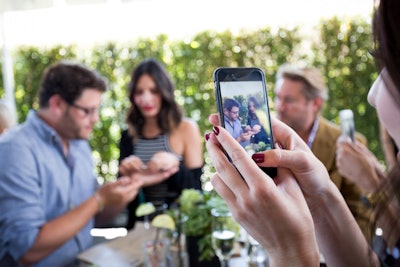
Influencer marketing is a concept that has been around a long time—think back to athletes on cereal boxes or celebrities promoting soda. But with the rise of online sharing through blogging, YouTube, Twitter, Facebook, Instagram, and more, influencer marketing has morphed. Now, brands want to work with people who can help them reach their target audience through social media—whether these people are celebrities in the traditional sense or not. And because so much of what is shared on social media is visual, influencer-engagement strategy is intimately connected to event strategy and creating experiences these social-media superstars will want to attend, photograph, and share with their followers.
Here are tips from three experts from agencies that regularly work with influencers on how to develop these relationships and how to craft events that appeal to them. Coltrane Curtis is the founder and C.E.O. of Team Epiphany, Laura Gavin is the director of production for MKG West, and Elle Cristo is the vice president of influencer strategy and analytics for Alison Brod Marketing and Communications.
Identify the right influencers.
One of the primary messages shared by the experts is to start by identifying the right influencers to invite. And “right” has less to do with the number of followers they have and more to do with who those followers are, how engaged they are, and whether that influencer has already demonstrated an affinity for the brand or topic. This will make whatever they share more authentic and well-received by their community of followers.
“Look at their personal interests outside of their profession, whether it’s tied to a philanthropic organization or nonprofit that the brand is also passionate about. It’s not only the surface stuff, but digging a little deeper to find the right fit,” Gavin says.
Incorporate influencers into the planning process.
Event planners should consider inviting influencers to help create the event strategy. “Ultimately what we like to do is to have that influencer have some skin in the game, if you will, with the actual execution,” Curtis says. “We want them to be connected to the experience beyond just being invited and asking them to amplify their experience.”
Examples of how to do this include tapping into the influencers’ interests and skills, such as asking those with an interest in food to help craft the menu or one with an interest in music to serve as DJ.
Tap into influencers as recruiters.
Influencers can help build buzz for an event long before it begins. For a consumer event at Sally Beauty in Dallas, Alison Brod Marketing and Communications worked with a local influencer who encouraged her fans to come meet and shop with her. Cristo says the influencer only had an Instagram following of about 150,000 people, but these were the local consumers they were trying to reach.
Curtis says they often use an “influencer-led” recruitment strategy. “What we know is that they exist in communities or packs, so why try to just amplify through one when you can amplify through the community?” he says.
Craft visual elements thoughtfully.
Everyone’s smartphone is equipped with a camera, so it’s a given that visual elements are critical at events. That’s particularly true for influencers, since posts with photos and videos are more likely to be seen and shared. The key for planners and designers is to create a variety of visual—and well-lit—opportunities throughout an event and allow the influencers to capture it in a way that suits them. Gavin calls these “Insta-bait” moments: unique product displays, interactive activities, backdrops, and more located throughout the venue that create “an exploratory journey” for the influencer, allowing them to determine what—and how—to shoot rather than trying to dictate that.
“It’s our job as event producers and experience curators that we have to give them something that’s visual and something that’s shareable, but something that allows them to find their eye and shoot it from their point of view,” Curtis says. “So even if 10 influencers shot one object, that those images look at the asset from completely different points of view, that’s the true test of a successful event.”
It’s also important to think about practical issues such as how the brand will be expressed visually—whether it’s just a logo or if there might be products for influencers to test—and also how the visual elements will translate to digital photography.
“It might look great in person but not in a 4 by 4 shot on my phone,” Cristo says. “And it can’t be too branded. It has to be something they are actually willing to post. You have to build your event with that lens and what will work on their channels.”
Do something unique and of value.
It’s not unusual for in-demand influencers to receive invitations to multiple events throughout the week, so give them a reason to R.S.V.P. “yes” to yours. Curtis says that weaving in “information dissemination” is important because influencers like to learn new and interesting things that they can share with their followers. That might mean asking bartenders to explain the ingredients and philosophy behind featured cocktails, or giving one-on-one interview time with the designer at a fashion event.
Interactive, hands-on experiences are also valued by influencers. “Do something that makes them want to keep talking and working with you so the relationship has longevity,” Cristo says.
Know that genuine engagement is more valuable than “pay-to-play.”
Paying influencers may not be necessary if an event is well-crafted. “If you are putting together an event that hits all the social points and is created for social content, you shouldn’t have to pay for them to post—they should just want to,” Cristo says.
She says she is more likely to pay an influencer to create a long-form piece of content than to attend an event. As some top-tier influencers have become celebrities for their audiences, Gavin says she does see many expecting to be paid, even for simply attending an event. In that case she recommends establishing clear expectations. “Whether it’s the attendance alone, the attendance and a social post, any post-events—all of those parameters should be clearly detailed any time you’re engaging in a pay-to-play situation,” Gavin says.
Curtis takes a stronger view. “We think the pay-to-play model is just stupid. It doesn’t work,” he says. “Brands, agencies that are stuck in this pay-to-play model, they have it seriously wrong. Influencers are bigger than their followers. Brands need to respect them so you know how to properly engage them.” Curtis says if he is going to pay an influencer, it would be to tap into their expertise to design the event. “That’s where we would use those dollars, because if the person actually helped to create what it is, do you think you have to pay them to amplify something that they co-created? It’s counter-intuitive,” he says.
Share their content.
Social interaction is of utmost importance to influencers, so planners should follow the people whom they invite to their events and like, comment, and share their posts from both their personal accounts and those tied to the brand.



















